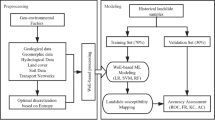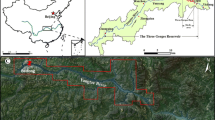Abstract
Landslide susceptibility mapping is vital for landslide risk management and urban planning. In this study, we used three statistical models [frequency ratio, certainty factor and index of entropy (IOE)] and a machine learning model [random forest (RF)] for landslide susceptibility mapping in Wanzhou County, China. First, a landslide inventory map was prepared using earlier geotechnical investigation reports, aerial images, and field surveys. Then, the redundant factors were excluded from the initial fourteen landslide causal factors via factor correlation analysis. To determine the most effective causal factors, landslide susceptibility evaluations were performed based on four cases with different combinations of factors (“cases”). In the analysis, 465 (70%) landslide locations were randomly selected for model training, and 200 (30%) landslide locations were selected for verification. The results showed that case 3 produced the best performance for the statistical models and that case 2 produced the best performance for the RF model. Finally, the receiver operating characteristic (ROC) curve was used to verify the accuracy of each model’s results for its respective optimal case. The ROC curve analysis showed that the machine learning model performed better than the other three models, and among the three statistical models, the IOE model with weight coefficients was superior.







Similar content being viewed by others
References
Ayalew L, Yamagishi H (2005) The application of GIS-based logistic regression for landslide susceptibility mapping in the Kakuda-Yahiko Mountains, Central Japan. Geomorphology 65(1–2):15–31
Borrelli L, Ciurleo M, Gullà G (2018) Shallow landslide susceptibility assessment in granitic rocks using GIS-based statistical methods: the contribution of the weathering grade map. Landslides 15(6):1127–1142
Bui DT, Tuan TA, Hoang ND et al (2017) Spatial prediction of rainfall-induced landslides for the Lao Cai area (Vietnam) using a hybrid intelligent approach of least squares support vector machines inference model and artificial bee colony optimization. Landslides 14(2):447–458
Calvello M, Ciurleo M (2016) Optimal use of thematic maps for landslide susceptibility assessment by means of statistical analyses: case study of shallow landslides in fine grained soils. In: Proceedings of ISL 2016, landslides and engineered slopes. Experience-theory and practice, Napoli, Italy, vol 2, pp 537–544. ISBN: 978-1-138- 02988-0
Chen W, Pourghasemi HR, Panahi M et al (2017) Spatial prediction of landslide susceptibility using an adaptive neuro-fuzzy inference system combined with frequency ratio, generalized additive model, and support vector machine techniques. Geomorphology 297:69–85
Devkota KC, Regmi AD, Pourghasemi HR et al (2013) Landslide susceptibility mapping using certainty factor, index of entropy and logistic regression models in GIS and their comparison at Mugling–Narayanghat road section in Nepal Himalaya. Nat Hazards 65(1):135–165
Feizizadeh B, Jankowski P, Blaschke T (2014) A GIS based spatially-explicit sensitivity and uncertainty analysis approach for multi-criteria decision analysis. Comput Geosci 64(1):81–95
Fell R, Corominas J, Bonnard C, On Behalf of the JTC-1 Joint Technical Committee on Landslides and Engineered Slopes et al (2008) Guidelines for landslide susceptibility, hazard and risk zoning for land use planning. Eng Geol 102(3–4):85–98
Guzzetti F, Reichenbach P, Ardizzone F, Cardinali M, Galli M (2006) Estimating the quality of landslide susceptibility models. Geomorphology 81(1):166–184
Hanley JA, McNeil BJ (1983) A method of comparing the areas under receiver operating characteristic curves derived from the same cases. Radiology 148(3):839–843
Heckerman D (1985) Probabilistic interpretations for MYCIN’s certainty factors. Conf Uncertain Artif Intell 4:9–20
Hong H, Chen W, Xu C et al (2016) Rainfall-induced landslide susceptibility assessment at the Chongren area (China) using frequency ratio, certainty factor, and index of entropy. Geocarto Int 32(2):139–154
Hong H, Tsangaratos P, Ilia I et al (2017) Comparing the performance of a logistic regression and a random forest model in landslide susceptibility assessments. The case of Wuyuan area, China. In: Workshop on world landslide forum, pp 1043–1050
Kumar R, Anbalagan R (2015) Landslide susceptibility zonation in part of Tehri reservoir region using frequency ratio, fuzzy logic and GIS. J Earth Syst Sci 124(2):431–448
Lagomarsino D, Tofani V et al (2017) A tool for classification and regression using random forest methodology: applications to landslide susceptibility mapping and soil thickness modeling. Environ Model Assess 22(3):201–214
Lee S (2007) Landslide susceptibility mapping using an artificial neural network in the Gangneung area, Korea. Int J Remote Sens 28:4763–4783
Luo W, Liu CC (2018) Innovative landslide susceptibility mapping supported by geomorphon and geographical detector methods. Landslides 15(3):1–10
Moore ID, Grayson RB (1991) Terrain-based catchment partitioning and runoff prediction using vector elevation data. Water Resour Res 27:1177–1191
Nasiri Aghdam I, Varzandeh MHM et al (2016) Landslide susceptibility mapping using an ensemble statistical index (Wi) and adaptive neuro-fuzzy inference system (ANFIS) model at Alborz Mountains (Iran). Environ Earth Sci 75(7):1–20
Nicu Cristi I (2018) Application of analytic hierarchy process, frequency ratio, and statistical index to landslide susceptibility: an approach to endangered cultural heritage. Environ Earth Sci 77(3):79
Pourghasemi HR, Rossi M (2016) Landslide susceptibility modeling in a landslide prone area in Mazandarn Province, north of Iran: a comparison between GLM, GAM, MARS, and M-AHP methods. Theor Appl Climatol 130:609–633
Pourghasemi HR et al (2013) Landslide susceptibility mapping using support vector machine and GIS at the Golestan Province, Iran. J Earth Syst Sci 122(2):349–369
Pourghasemi HR, Moradi HR et al (2014) GIS based landslide susceptibility mapping with probabilistic likelihood ratio and spatial multi-criteria evaluation models (North of Tehran, Iran). Arab J Geosci 7(5):1857–1878
Pourghasemi HR, Yansari ZT et al (2018) Analysis and evaluation of landslide susceptibility: a review on articles published during 2005–2016 (periods of 2005–2012 and 2013–2016). Arab J Geosci 11(9):193
Pradhan B (2013) A comparative study on the predictive ability of the decision tree, support vector machine and neuro-fuzzy models in landslide susceptibility mapping using GIS. Comput Geosci 51(2):350–365
Regmi AD, Yoshida K, Dhital MR et al (2013) Effect of rock weathering, clay mineralogy, and geological structures in the formation of large landslide, a case study from Dumre Besei landslide, Lesser Himalaya Nepal. Landslides 10(1):1–13
Shortliffe EH (1975) A model of inexact reasoning in medicine. Math Biosci 23(3):351–379
Süzen ML, Doyuran V (2004) A comparison of the GIS based landslidesusceptibility assessment methods: multivariate versus bivariate. Environ Geol 45(5):665–679
Trigila A, Frattini P, Casagli N et al (2013) Landslide susceptibility mapping at national scale: the Italian case study. In: Landslide science and practice, pp 287–295
Wang Q, Li W, Chen W, Bai H (2015) GIS-based assessment of landslide susceptibility using certainty factor and index of entropy models for the Qianyang County of Baoji City, China. J Earth Syst Sci 124(7):1399–1415
Wu Y, Li W et al (2016) Landslide susceptibility assessment using frequency ratio, statistical index and certainty factor models for the Gangu County, China. Arab J Geosci 9(2):1–16
Yin K, Yan T (1988) Statistical prediction model for slope instability of metamorphosed rocks. In: Proceedings of the 5th international symposium on landslides, vol 2, pp 1269–1272
Youssef AM, Pourghasemi HR et al (2016) Landslide susceptibility mapping using random forest, boosted regression tree, classification and regression tree, and general linear models and comparison of their performance at Wadi Tayyah Basin, Asir Region, Saudiarabia. Landslides 13(5):839–856
Zhou C, Yin K et al (2018) Landslide susceptibility modeling applying machine learning methods: a case study from Longju in the Three Gorges Reservoir area, China. Comput Geosci 112:23–37
Acknowledgements
This paper was prepared as part of the projects “The risk assessment of geological hazards induced by reservoir water level fluctuation in Chongqing, Three-Gorges Reservoir, China.” (No. 2016065135) and “The study of mechanism and forecast criterion of the gentle-dip landslides in The Three Gorges Reservoir Region, China” (No. 41572292) funded by the National Natural Science Foundation of China.
Author information
Authors and Affiliations
Corresponding author
Rights and permissions
About this article
Cite this article
Xiao, T., Yin, K., Yao, T. et al. Spatial prediction of landslide susceptibility using GIS-based statistical and machine learning models in Wanzhou County, Three Gorges Reservoir, China. Acta Geochim 38, 654–669 (2019). https://doi.org/10.1007/s11631-019-00341-1
Received:
Revised:
Accepted:
Published:
Issue Date:
DOI: https://doi.org/10.1007/s11631-019-00341-1




